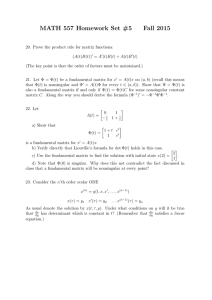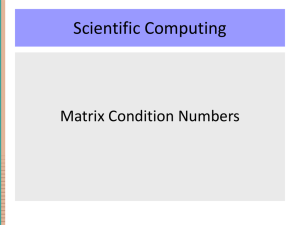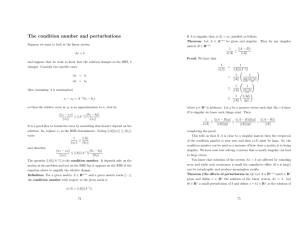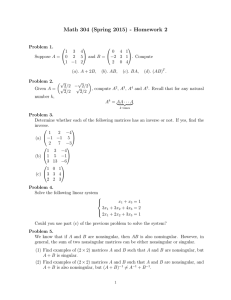Document 10943997
advertisement
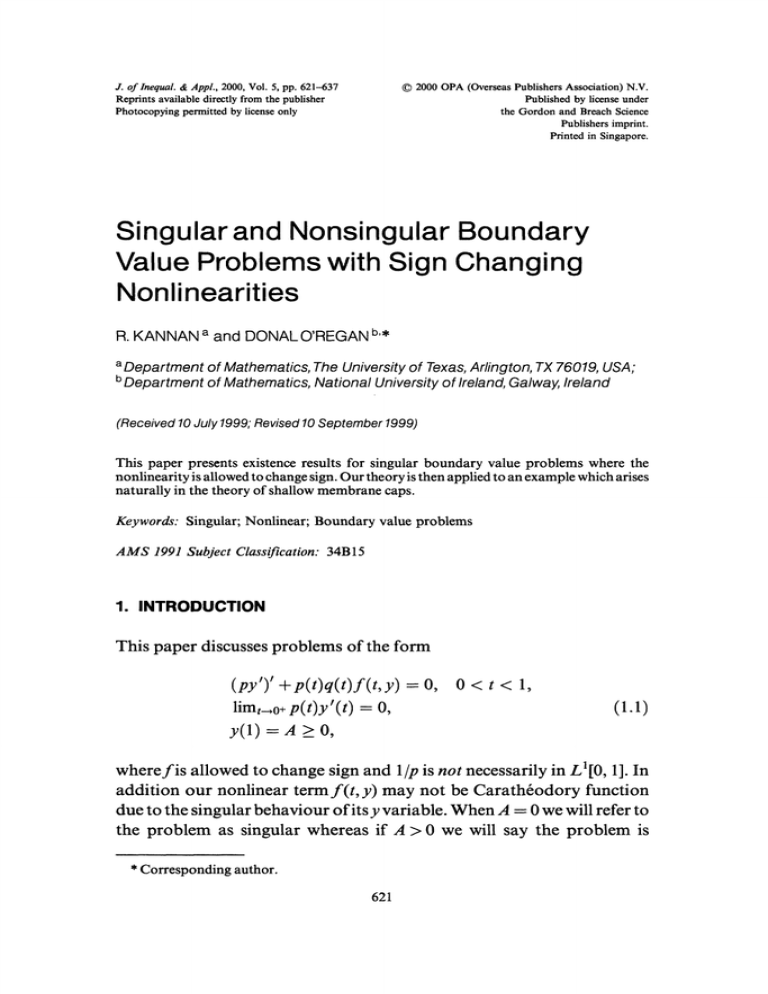
(C) 2000 OPA (Overseas Publishers Association) N.V.
Published by license under
the Gordon and Breach Science
Publishers imprint.
Printed in Singapore.
J. oflnequal. & Appl., 2000, Vol. 5, pp. 621-637
Reprints available directly from the publisher
Photocopying permitted by license only
Singular and Nonsingular Boundary
Value Problems with Sign Changing
Nonlinearities
R. KANNAN a and DONAL O’REGAN
a
Department of Mathematics, The
b
University of Texas, Arlington, TX 76019, USA"
Department of Mathematics, National University of Ireland, Galway, Ireland
(Received 10 July 1999; Revised 10 September 1999)
This paper presents existence results for singular boundary value problems where the
nonlinearity is allowed to change sign. Our theory is then applied to an example which arises
naturally in the theory of shallow membrane caps.
Keywords: Singular; Nonlinear; Boundary value problems
AMS 1991 Subject
Classification." 34B15
1. INTRODUCTION
This paper discusses problems of the form
(py’)’ + p(t)q(t)f(t, y) 0,
limt0/ p(t)y’(t)
y(1) A > 0,
0,
0<t< 1,
(1.1)
wherefis allowed to change sign and lip is not necessarily in zl[0, 1]. In
addition our nonlinear term f(t, y) may not be Carath60dory function
due to the singular behaviour of its y variable. When A 0 we will refer to
the problem as singular whereas if A > 0 we will say the problem is
* Corresponding author.
621
R. KANNAN AND D. O’REGAN
622
nonsingular. The theory presented in this paper was motivated by a
nonsingular problem arising in the theory of shallow membrane caps
[3,4,6], namely
(t3y’) ’+
limt_.,0/
ao--- bot 2"-1 =0, O<
Y
t<
(1.2)
t3y’(t) O,
y(1)=A>0, a0>0, b0>0 and-y>l.
Our paper will be divided into two main sections. In Section 2 we present
a slight variation of the classical theory of upper and lower solutions (see
[3]) so that (1.1) can be discussed in both the singular and nonsingular
situation. Section 3 discusses in more detail the singular problem. The
theory presented here extends and generalizes some ideas introduced in
[1,8]. In particular the results in [1] only hold if f(t,y)=f(y) for
E [0, 1]\(1/2, ). In our paper we replace this with the less restrictive
assumption f(., y) is nondecreasing on (0, 1/2) for each fixed y E (0, )
(see Remark 3.4 for a more general situation).
2. UPPER AND LOWER SOLUTION APPROACH
In this section we discuss the singular and nonsingular problem
(py’)’ + p(t)q(t)f(t, y) O,
limt0/ p(t)y’(t)
y(1) A _> 0.
0<t<l,
(2.1)
O,
Suppose the following conditions are satisfied:
pEC[0,1]NC1(0,1) withp>0 on(0,1),
qE
fO
p(s)q(s) ds <
C(O, 1) with q > 0
and
fo1 -p fO
on
(2.2)
(2.3)
(0, 1),
p(s)q(s) ds dt <
,.
(2.4)
SINGULAR AND NONSINGULAR BVPs
623
C[0, 1] C2(0, 1) with p3’ AC[O, 1], /3(1) > A,
lim,o+p(t)13’(t) < 0 and p(t)q(t)f(t,3(t)) + (p/3’)’(t) <_ 0
for 6 (0, 1),
there exists/3 E
(2.5)
C[0, 1] C 2 (0, 1) with pa’ AC[O, 1],
a(t) _< (t) on [0, 1], a(1) < A, lim/_,o+ p(t)a’(t) >_ 0 and
p(t)q(t)f(t,a(t)) + (pa’)’(t) >_ 0 for
(0, 1)
there exists a
(2.6)
and
[0, 1], f(t,u) E R for u [a(t),/3(t)].
for each
(2.7)
Let
f(t, 13(t)) + r(t3(t) -y), y >_/3(t),
f*(t,y)= f(t,y),
<y<
f(t, a(t)) + r(a(t) y), y <_ a(t)
and r" R
[-1, 1] is the radial retraction defined by
Ixl _<
Ixl >
x,
Finally we assume
f*" [0, 1]
R
R is continuous.
(2.8)
THEOREM 2.1 Suppose (2.2)-(2.8) hold. Then (2.1) has a solution y
(here y C[0, 1] CZ(O, 1) withpy’ AC[O, 1]) with a(t) < y(t) </3(t)for
t [0, 1].
Proof To show (2.1) has a solution we consider the problem
(py’)’ +p(t)q(t)f*(t,y) O, 0<t<l,
limto/ p(t)y’(t)
y(1) A > O.
O,
(2.9)
-
R. KANNAN AND D. O’REGAN
624
Solving (2.9) is equivalent to finding a y C[0, 1] to
y(t)
A+
p(s)q(s)f*(s, y(s)) dsdx.
Define the operator N: C[0, 1]
Ny(t)
A+
C[0, 1] by
p(s)q(s)f* (s, y(s)) ds dx.
A standard argument [3,9] implied N: C[0, 1]-- C[0, 1] is continuous
and compact. Now Schauder’s fixed point theorem guarantees that N
has a fixed point i.e. (2.9) has a solution y E C[0, 1]n C e(0, 1) with
py AC[0, 1]. The result will follow once we show
a(t) y(t)
fl(t) for
E
[0, 1].
(2.10)
We now show
y(t) <_ (t) for E [0, 1].
(2.11)
Suppose (2.11) is not true. Then y fl has a positive absolute maximum
at tl [0, 1) (note y(1)=A <(1)). First let us take tl E(0, 1). Then
(y-/)’(tl) 0 and (p(y- fl)t)t(tl) _< O. However since y(tl) >/(tl) we
have
(p(y-’)’(t)
-p(tl)q(tl)[f(tl,(t)) + r(3(t) -y(t))]- (p/3’)’(t)
>_ -p(tl)q(tl)r((t) y(tl)) > O,
a contradiction. It remains to consider the case t
lim p(t)[y- fl]’(t)
t---0+
-lim+ p(t)’(t)
t-.0
0. Notice
> 0,
which is a contradiction unless limt_o/p(t)(t)--O. So assume
limto/p(t)/(t)--O. Now there exists # 0 with y()-/()0 for
[0,/]. Thus for (0, #) wc have
{p(s)q(s)[f(s,(s)) + r(fl(s) -y(s)) + (p’)’(s)}ds > 0,
SINGULAR AND NONSINGULAR BVPs
625
and this contradicts the fact that y fl has a positive absolute maximum
at tl =0. Thus (2.11) holds. Similarly we can show
a(t) <_ y(t) for
t
[0, 1].
(2.12)
Our result follows.
The following examples arise in the theory of shallow membrane caps,
see [2,4,6] and their references.
Example 2.1 Consider
(t3y’) +
limt_0+
y(1)
t3
b0 t2,-I ) -0,
-a0--Y
y, (t)
0
< < 1,
0,
(2.13)
A > 0,
where ao > 0, bo > 0 and 3’ > 1. Let
f(t)
max A,
If 5’ > 2 let
a(t)=a0 wherea0=min
A, -0 +V +
whereas if < -), < 2 let
.(t)
.0t
Then (2.13) has a solution y E C[0, 1] f’l C2(0, 1) with t3y AC[0, 1] and
c(t) <y(t) <_ (t) for [0, 1].
To see this we will apply Theorem 2.1. Choose e, 0 < e < 2 so that
3, q(t)
and
3’ > 2 e/2. Take p(t)
f(t,y)
8y 2
ao--- bot 27-4+e
Y
R. KANNAN AND D. O’REGAN
626
Notice (2.2)-(2.4) and (2.7) are satisfied. If 7 > 2 then
f*(t,y)
ot
aOo
t’
w-v
ao
t
Y
o
bot 2’-4+’ -Jr- r(/3o y),
y _>/3o,
bot2-4+e
ao < y </3o,
hot -4+’ + r(o ), y <
whereas if < ’7 < 2 then
y >_13o,
aot 2- < y </30,
f*(t,y)
+ r(aot 2- y),
y <_ ao t2-’r.
Clearly (2.8) is satisfied since e > 4- 27. To see that/3(0 =/30 satisfied
(2.5) notice/3(1) > A, lim/__.o+ t3/3’(t)= 0 and
p(t)q(t)f(t,(t)) + (p’)’(t)
-0
bot 2"r- <_ -bot 2"r-1 _< 0
ao
for tE(0, 1) since /3(0=/30> 1/(8ao). It remains to show (2.6). We
consider the cases ’7 > 2 and < < 2 seperately.
,
Case (i) "7 > 2 Now a(t) < 3(t), a(1) < A, limt_o+ t3a’(t)=0 and
p(t)q(t)f(t, a(t)) + (pa’)’(t)
3ao bot 2,),ao
8a
>
ao
8
(1 8aoao 8boao2)
,
t3bo
,o
xo ,o + xo > o
o0
t3bo(
bot2._4)
+ ao
8-o)
SINGULAR AND NONSINGULAR BVPs
627
for E (0, 1) since ao _< Xo; here
-o + V’- + 2b--7
xo
Hence (2.6) is true in this case.
Case (ii) 1<’7<2 Now
limt_,o+ 4-’ 0 and
a(1)_<A,
limto+ 3a’(t) ao(2 ’7)
p(t)q(t)f(t, a(t)) + (pa’)’(t)
at2-Vo
ao(2 ’7)(4
> co(2 ’7)(4 ’7)/3--r q_ t2-r-1
ao(2 ’7)(4 ’7)t 3-’r
(
ao
to
bo
bo)
t2’-lb (o xo)(o + xo) >_ o
2
for E (0, 1) since ao < Xo; here
xo=
Hence (2.6) is true in this case.
Now Theorem 2.1 guarantees that (2.13) has the desired solution.
Example 2.2 Consider
(t3
(t3y’) ’/ y2 bt2"-I
lim/o+ t3y’(t) O,
)
O, 0<t<l,
(2.15)
y(1) =A > 0,
where bo > 0 and ’7 > (note (2.15) is (2.13) with ao
c(t)
{ 8x/-o,}
min A,
o1
and
3(t)
0). If’7 > 2 let
24A2(1
t) + A,
R. KANNAN AND D. O’REGAN
628
whereas if < ’7 < 2 let
a(t)=alt 2-’ and /3(t)=A/
Then (2.15) has a solution y E C[0, 1] N C2(0, 1) with t3y
a(t) <y(t) < (t) for [0, 1].
A C[0,
and
To see this we will apply Theorem 2.1. Choose e, 0 < e < 2 so that
3, q(t) t-" and
’7 > 2 /2. Take p(t)
f(t,y)
b0t2"r-4+e.
8y 2
Notice (2.2)-(2.4), (2.7) and (2.8) are satisfied. To show (2.5) and (2.6)
hold we consider the cases ’7 > 2 and < "7 < 2 seperately.
Case (i) ’7 > 2 Notice (t) (1/(24A2))(1 t) / A satisfies (2.5) since
3(1)--A, limt__.0+ t3fl’(t) 0 and
p(t)q(t)f(t,/3(t)) + (p’)’(t)
2
8A2
<
8[(1/(24A2))(1
t)+ A]
t [ ----;.. /--zx. bot 23,-3
t6(0,1). Also a(t)=a
limto+ t3a’(t) 0 and
for
P(t)q(t)f(t’a(t)) / (Pa’)’(t)
t3
2
bot 2"r-1
<_ 0
satisfies
(2.6) since a(1)<A,
(-1-- bt2/-4) >- t3(bO
bot3(1
bt2"r-4)
2"r-4) _> 0
for C (0, 1).
Case (ii) < "7 < 2 Notice/3(t)
A/
p(t)q(t)f(t, fl(t)) + (pfl’)’(t) <_
1/ satisfies (2.5) since
t3bo bot 2"rbot ’r- (t4-’
1) <_ 0
SINGULAR AND NONSINGULAR BVPs
629
for E (0, 1). Also a(t)--al t2-’ satisfies (2.6) since
p(t)q(t)f(t, a(t)) + (pa’)’(t)
al(2-’7)(4-’),) t3-’ + t2"-l
(- bo)
>_0
for E (0, 1).
Now Theorem 2.1 guarantees that (2.15) has the desired solution.
3. SINGULAR PROBLEM USING A GROWTH APPROACH
In this section we discuss the singular problem
(py’)’ /p(t)q(t)f(t,y)
limt0/ p(t)y’(t)
O, 0 < < 1,
(3.1)
0,
y(1) =0.
We are interested in nonnegative solutions (in fact solutions y with y > 0
on [0, 1)). One can observe that if we use the upper and lower solution
technique of Section 2 (we use (3.7) and (3.8) to construct the upper
solution and (3.5) and (3.6) to construct the lower solution) we have to
assume (2.8). As a result we present a different approach for singular
problems in this section. We remark here that a similar theory could be
obtained for nonsingular problems (the proofs are a lot easier in this
case). In particular the results in this section improve those in [1] since in
[1] we had to assumef(t, y)=f(y) for t [0, 1]\(l/n, 1 -(l/n)) for some
n {3,4,...}.
Throughout this section we will assume (2.1)-(2.4) hold. For our first
result we will suppose the following conditions are satisfied:
f" [0, 1] x (0, )
f(.,y) is nondecreasing on
(0, 31-)
R is continuous.
(3.2)
for each fixed y
(0, x). (3.3)
If(t,y)l < g( y) + h( y) on [0,1] x (0,x)
with g > 0 continuous and nonincreasing on
h > 0 continuous on [0, ) and
h/g nondecreasing on (0, o).
(0, x),
(3.4)
R. KANNAN AND D. O’REGAN
630
let n E {3, 4,...} and associated with each n we have a constant pn
such that {Pn} is a nonincreasing sequence with limt pn 0
and such that for 1In < < we have p(t)q(t)f(t, pn) > 0
(3.5)
there exists a function a E C[0, 1] N C2(0, 1)
with pa’ AC[O, 1], limt-_,o+ p(t)a’(t) a(1)
such that p(t)q(t)f(t,y) + (p(t)a’(t))’ > 0
for (t,y) (0, 1) x {y (0, x) y < a(t)}
O,
a
> 0 on [0, 1)
(3.6)
-
for any R > 0, 1/g is differentiable on
a.e. on (0, R] and g/g L [0, R]
and
(
1
ce(0,)sup {1 + h(c)/g(c)}
THEOREM 3.1
(0, R] with g’ < 0
f0c dg)) f01 f0
>
(3.7)
p(x)q(x) dx ds. (3.8)
Suppose (2.2)-(2.4) and (3.2)-(3.8) hold. In addition
assume
(3.9)
p(x)q(x)g(a(x)) dx ds < o
-
satisfied. Then (3.1) has a solution y (here y C[0, 1] fq C2(0, 1)
py A C[0, 1]) with y( t) > a(t) for [0, 1].
Proof Choose M > 0 and e > 0 (e < M) with
is
{1 + h(M)/g(M))
>
p(x)q(x)dxds.
Let m0{3,4,...} be chosen so that Pmo <
{mo, m0 + 1,...}. We begin by showing
(py’)’ +p(t)q(t)f**(t,y)
limt__,o/ p(t)y’(t)
y(1)=pn,
O,
and let
with
(3.10)
N+=
O, 0<t<l,
(3.11) n
SINGULAR AND NONSINGULAR BVPs
631
has a solution for each n E N+; here
(1)
Y>Pn
f -,Y
and
0<t<-n
f(t,y), y>_o and -<_t<_l
n
f**(t,y)
f (t,p,) + p,
f -’n
y, y < p and -_<t<_l
n
On +p-y, y<p and
O<_t<_-.n
Remark 3.1 Notice (3.4) implies If**(t, Y)I < g(Y) + h(y) if y > pn and
E[0, 1]. Also (3.3) impliesf**(t, y) >f(t,y),t E (0, 1) foreach fixedy > p,,.
To show (3.11) has a solution for each n EN + we apply
[1, Theorem 2.9]. Fix n E N + and consider the family of problems
(py’)’ + Ap(t)q(t)f** (t,y) O,
limt-0/ p(t)y’(t)
y(1)
0 < < 1, 0 < A < 1,
(3.12)
0,
pn.
First we show
y(t) > Pn for E [0, II
(3.13)
for any solution y to (3.12). Suppose (3.13) is not true. Then yhas a negative absolute minimum at to E [0, 1) (note y(1) p,, 0). First
let us take the case t0E(0, 1). Then y’(to)=0 and (py’)’(to)>0 (note
y(to) Pn < 0). However
(py’)’ to)
-.kp(to)q(to) f** (to, y(to)
-.kp(to)q(to)[f(to, Pn) + Pn -y(t0)]
if- <_ to < 1
n
--Ap(to)q(to)[f(,pn)+Pn--Y(’0)]
if 0
1
< to <_ n
<0,
a contradiction. It remains to consider the case t0--0. Notice
limt_o+p(t)[y-p]’(t)=O. Also since y(0)-p,<0 there exists 6>0
R. KANNAN AND D. O’REGAN
632
with y(s)
Pn < 0 for s E [0, 6]. Thus for E (0, 6),
p(t)(y- pn)’(t)
Ap(s)q(s)f**(s,y(s))ds < O,
and this contradicts the fact that y- pn has a negative absolute maximum at to 0. Thus (3.13) holds.
Now since y(1) p and y(t) > p on [0, we may assume the absolute
maximum of y occurs at say tn [0, 1), so limt__,t,p(t)y’(t) 0. Without loss of generality assume Y(6)> e. For x (0, 1) we have from
Remark 3.1 that
-(p(x)y(x)) <_
p(x)q(x)
g( y(x)
{+
h(y(x))
g( y(x)-
}
Integrate from t to t(t > t,,) to obtain
-p(t)y’(t)
g(y(t))
<_{1/
and so (see (3.7))
h(y(tn))}
{ /g(y(tn)--------
-y’(t)
<
g(y(t))
o’t
p(s)q(s)ds for
(tn, 1).
Integrate from t to to obtain
du
g(u)
h(y(tn))}ftnl fo
{ +g(y(tn)------
< 1
p(s)q(s) dsdt
and so
du
g(u)
<
h(y(t,,))} fol lot
{ +g(y(tn)-----
p(s)q(s)dsdt.
(3.14)
Now (3.10) and (3.14) imply lylo=sup,to, llly(t)l#M. Thus
[1, Theorem 2.9] implies (3.11)" has a solution Yn with ly.10< M.
SINGULAR AND NONSINGULAR BVPs
633
Also (as above),
Pn < Yn(t) < M fortE[0,1].
Next we obtain a sharper lower bound on Yn, namely we will show
yn(t) > a(t) for E [0, 1].
(3.16)
Suppose (3.16) is not true. Then yn a has a negative absolute minimum
at
(0, 1). Then
[0, 1) (note y,(1) a(1) p,, > 0). First let us take
(y,, a)’(tl) --0 and (P(Yn a)’)’(tl) > 0. However since 0 < y,(tl) <
a(tl) and yn(tl) > p, we have from (3.6) and Remark 3.1 that
(P(Yn
o)’)’(tl)
[p(tl)q(tl)f** (tl, yn(tl)) + (po’)’(tl)]
<_ --[p(tl)q(tl)f(tl,Yn(tl)) + (pa’)’(tl)]
< 0,
a contradiction. It remains to consider the case tl--0. Notice
limt_o+p(t)[y-a]’(t) 0. Now there exists # > 0 with 0 < y(s) < a(s)
for [0, #] (also note y(s) > pn for s [0,/z]). Thus for E (0, #) we have
p(yn -a)’(t)
[p(s)q(s)f**(s,y,(s)) + (pa’)’(s)] ds < O,
and this contradicts the fact that y,- a has a negative absolute minimum at t 0. Thus (3.16) is true.
Remark 3.2 It is easy to check directly, using (3.6) and the ideas used to
prove (3.14), that a(0 _< M for all [0, 1].
We shall now obtain a solution of (3.1) by means of the Arzela-Ascoli
theorem, as a limit of solutions of (3.11)’. To this end we will show
{Y,,},,ev/
is a bounded, equicontinuous family on
[0, 1].
To show equicontinuity notice
h(yn(t))}
{ +g(yn(t))
{ +gM
h(M) k
If**(t,y(t))l < g(y(t))
<_ g(a(t))
for E
(0, 1).
(3.17)
R. KANNAN AND D. O’REGAN
634
This together with the differential equation gives
lYn’(t)l _< p-
+ g(M
p(s)q(s)g(a(s)) ds for e (0, 1)
and this together with (3.9) establishes (3.17).
The Arzela-Ascoli theorem guarantees the existence ofa subsequence
No of N + and a function y E C[0, 1] with Yn converging uniformly on
[0, 1] to y as n cx through No. Also y(1) 0 and y(t) > a(t) for E [0, ].
Fix t(0,1) and let nlN0 be such that 1/nl<t<l. Let NI=
{n No: n > nl). Now yn, n N1, satisfies the integral equation
yn(t)
-
1In
yn(0)-
X[1/n,t] (X)
p(s)q(s)f
(!, yn(S))
ds
x
+
/o p(s)q(s)f(s, yn(s))x[1/n,x](s)ds
-
dx.
For s e [0, t]we havef(s, y,(s)) f(s, y(s)) uniformly on compact subsets
through NI gives
of[0, t]x (0, M], so letting n
y(t)
y(O)
p(s)q(s)f(s,y(s)) dsdx.
We can do this argument for each
(3.18)
(0, 1).
Remark 3.3 Notice to apply this step we need only f0a 1/p(x) fox p(s) x
q(s)g(a(s))ds dx < for any a (0, 1). This is automatically satisfied
since (2.4) holds and a(s) > 0 for s [0, a]. As a result (3.9) is not needed
in this step.
Therefore from the integral equation (3.18) we see that (py’)’(t)+
p(t)q(t)f(t,y(t))=O, 0 < < and limto/p(t)y’(t)=O.
Remark 3.4 If in (3.5) we replace 1/n < < with 0 < <
1/n then
on
one would replace (3.3) with: f(t,y) is nonincreasing
(, 1) for
SINGULAR AND NONSINGULAR BVPs
635
each fixedy E (0, ). More generallyifin (3.5)we replace 1/n < < with
1In < < 1- 1In then one would replace (3.3) with the following: for
any fixed y E (0, ) there exists e, 0 < e < 1/2 with f(t, y) nondecreasing
on (0, e) and f(t,y) nonincreasing on (1-e, 1). Finally if in (3.5) we
replace 1/n < < with 0 < < then assumption (3.3) is not needed.
It is worth remarking that the only place we needed assumption (3.9)
was in proving (3.17). It is possible to put other conditions on p, q andf
to guarantee that (3.17) holds.
THEOREM 3.2 Suppose (2.2)-(2.4) and (3.2)-(3.8) hold. In addition
assume
ds
p--<
(3.19)
and
lg’(t)l
/z
-i
(3.20)
dt
are satisfied. Then (3.1) has a solution y (here y
py’ AC[O, 1]) with y(t) >_ a(t)for [0, 1].
C[O,
fq
Cz(O, 1) with
The proof is essentially the same as in Theorem 3.1 except to
prove (3.17) we use the argument in [7, p. 74].
Proof
Remark 3.5 One can usually "construct" a from the differential
equation. For a more detailed discussion we refer the reader to [1,5,8].
Example 3.1 The boundary value problem
(t3y’)’+tg(y )
-#
limt-,o+ t3y’(t) O,
y(1) 0, #>0
has a solution y C[0,
t [0,
=0, O<t<l,
(3.21)
N C2(0, 1) with py’ A C[0, 1] and y(t) > 0 for
1).
We will apply Theorem 3.1. Take p(t)=t 3, q(t)= l/t, f(t,y)-1/V/-fi #, g(y)=l/v/-fi and h(y)=/z. Notice (2.2)-(2.4) and
R. KANNAN AND D. O’REGAN
636
(3.2)-(3.4) are satisfied. Choose no E { 1,2,...} so that no > #2 and let
o
n+no
Now (3.5) is true since
t2[(n + no) 1/2 #]
p(t)q(t)f(t, Pn)
/2
> t2.
fort(0,1).
v.o-#)>0
Next let
t) where a0 > 0 is chosen so that 3a/2 + #a/9 <
ao(1
a(t)
1.
Now a(1)=0, limt__+o/t3a’(t)=O and for (t,y)E(0,1)x {yE(0, oo):
y < ce(t)},
p(t)q(t)f(t,y) + (pa’)’(t)
#
t2
X/-X/-(1
3aot 2 >
t)
#
2
-
v/ao(1 t)
3a0 > t2
2
( .v- 3ag/) > 0.
3aot 2
#
#--
3ao
Thus (3.6) holds. In addition (3.7) and (3.8) are satisfied since
sup
c(0,)
(’{1 +
Finally note (3.9) hold since
75
-
/og )
du
h(c)/g(c)}
sg((s)) ds dt
sup
c(O,c)
(l+#x/ c7 )
-[5
x/1
-<10"11 fo
t3x/1
s 2 ds dt
fill dt<
3v Jo v/1
Now Theorem 3.1 guarantees the result.
dsdt
s
SINGULAR AND NONSINGULAR BVPs
637
References
[1] R.P. Agarwal and D. O’Regan, Positive solutions to superlinear singular boundary
value problems, J. Computational and Appl. Math., $$ (1998), 129-147.
[2] J.V. Baxley and S.B. Robinson, Nonlinear boundary value problems for shallow
membrane caps II, J. Computational and Appl. Math., 88 (1998), 203-224.
[3] L.E. Bobisud and D. O’Regan, Positive solutions for a class of nonlinear singular
boundary value problems at resonance, J. Math. Anal. Appl., 184 (1994), 263-284.
[4] R.W. Dickey, Rotationally symmetric solutions for shallow membrane caps, Quart.
Appl. Math., 47 (1989), 571-581.
[5] P. Habets and F. Zanolin, Upper and lower solutions for a generalized EmdenFowler equation, J. Math. Anal. Appl., 181 (1994), 684-700.
[6] K.N. Johnson, Circularly symmetric deformation of shallow elastic membrane caps,
Quart. Appl. Math., 55 (1997), 537-550.
[7] D. O’Regan, Some existence principles and some general results for singular nonlinear
two point boundary value problems, J. Math. Anal. Appl., 166 (1992), 24-40.
[8] D. O’Regan, Singular differential equations with linear and nonlinear boundary
conditions, Computers Math. Appl., 35(3) (1998), 81-97.
[9] D. O’Regan, Theory ofSingular Boundary Value Problems, World Scientific, Singapore,
1994.
